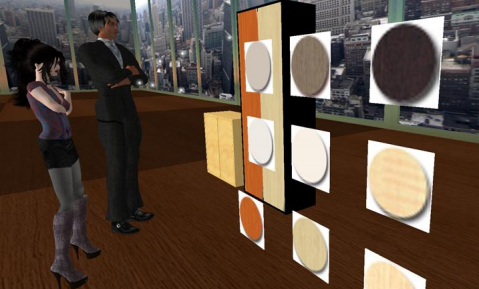Using tools built on the OpenSim virtual world platform could transform fashion design, Fashion Research Institute, Inc. CEO Shenley Winkler said in a paper released yesterday, by saving money, reducing time to market, and cutting the industry’s carbon footprint.
People may be most familiar with virtual fashion in the form of the clothing and accessories industry in Second Life, but this model isn’t yet ready to scale up, she said.
“At the moment, the bulk of mass market consumers aren’t present [in the virtual worlds],” she wrote, “and the consumer population which is there, just like in the early days of the Web, is often focused on gaming and adult entertainment.”
This may change in the future, she added, as the scalability challenges are met.
But the real value proposition today, she said, lies in bringing 3D virtual environments into the design industry’s production process, to shorten design cycle times and cut physical sample costs.

There are 3D design systems currently on the market, but they come from the engineering space, she said, and are too difficult to use. The Second Life user interface, however, which is shared by the OpenSim platform, is a better fit.
“This is a more intuitive solution for a sashion designer, because fashion designers do not have an engineering backgorund and the tols designed for engineers are not appropriate for designers,” she wrote. “The complexity of engineering CAD tools is overkill for fashion, the interfaces are not intuitive, and they do not lead to compliance by the designers in using them, and they are not industry standard.”
The Fashion Research Institute collaborated with IBM Research to create one just design environment, called the Black Dress Design Studio.
The studio promises to cut design time by 75 percent of the design time, and reduce the need for physical samples by 65 percent.
Black Dress Design Studio lets fashion firms create 3D designs, then produces factory-ready specifications.
“Managing the design process itself becomes transparent, as executives will better be able to understand the design process itself as well as to track productivity of individual designers,” she wrote.
In addition, the platform can be used for collaboration.

“Factory representatives can be brought to the design space for product-centered discussions about any given design,” Winkler wrote. “Production problems can be resolved quickly by bringing all of the stakeholders of development together to discuss the product in real time, with the product shown in 3D.”
When the designers and factory representatives speak different languages, OpenSim has built-in translation tools. And the engaging, immersive environment can help form relationships that cross international borders.
Other technology platforms besides OpenSim were considered, but OpenSim was chosen because of its flexibility and familiar interface.
“OpenSim has the critical advantage that enterprises can adapt it to their back end systems,” Winkler wrote. “And the skilled Second Life user based could just ‘step over’ into their brave new world without a change of interface. The minor differences in OpenSim content creation are not such issues as to be showstoppers.”
- OSgrid back online after extended maintenance - April 16, 2025
- Analysts predict drop in headset sales this year - March 25, 2025
- OSgrid enters immediate long-term maintenance - March 5, 2025
